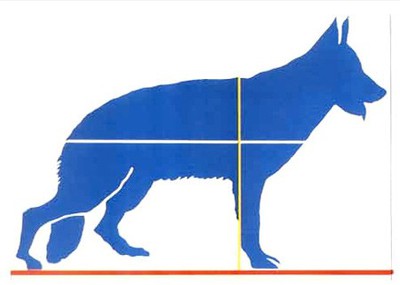Puppy Proportions: Comparing Growth Spurts and Weight Gain in Your Dog's Early Months
Abstract
Planning on getting a new puppy soon? Why not use some of your play time with puppy to study growth rates and puppy development? You can easily chart a young puppy's weekly weight and growth over several months to compare how quickly body dimensions and bone lengths change. While this project may take some time, it's well worth the effort. You might be amazed at the dramatic growth of your "canine kid," and what other project combines science with as much fun, or a more adorable subject?Summary
Darlene E. Jenkins, Ph.D.
This project is based on a DragonflyTV episode.
Objective
The goal of this project is to find out if growth rates are different among a puppy's weight, height, length, paw size and selected bones during the early months of life.
Introduction
Growth is a basic requirement of living organisms. But obviously, not all things grow to the same size or at the same rate. Mammals, for one example, all share similar mammalian characteristics but vary considerably in size and shape from huge blue whales to leggy giraffes to tiny shrews. Even within the same animal, different parts grow at different times and at different rates during early development. If that weren't true, as adults we'd all end up looking like oversized babies with proportionately huge heads, large bellies, and stubby legs and arms! Normal growth and development requires precisely timed and ordered changes to ensure proper structure and proportions as all life forms mature.
In this project, you will investigate growth spurts of the most charming of all subjects, your new puppy dog. And what a convenient example of growth your puppy can be. Within just a period of weeks to a few months, you can document and compare some tremendous changes in your puppy's weight, height, and length.
You will also chart the growth rates of selected bones of the feet, legs, head, or tail to study relative changes in body proportions over time. Even in humans, body proportions change dramatically as babies grow into children and then into adults. At birth, a baby's head usually represents 33% of the body's length, but in an adult the head is less than 10% of height. Legs in adults, however, represent 30% of total height compared to only 15% in a baby. The measurements of your puppy will let you see how selected body regions like the legs, head, tail, or feet grow during the early months in proportion to his/her height.
The foot of a dog is particularly interesting. Actually, calling it a "foot" is inaccurate because canines technically walk on their "toes" because the bones of a dog's "palms" and "soles" of the feet are elevated off the ground. This positioning provides increased flexibility and helps absorb some of the shock from running and jumping. In one of the experiments in this project, you'll monitor the changes in your puppy's feet by taking paw prints each week and measuring the changes in paw size over time.
Before you get started, do a little background research. You'll see a list of research terms, basic questions, and a bibliography in the next section. Your puppy's veterinarian might also be a valuable resource for this project. You should find out, for example, the standard growth rate for dogs that are similar in size or of the same breed(s) as your puppy. Also, learn the major bones of a dog's skeleton along with the basic vocabulary used to describe parts of a dog. See if you can identify anatomical "landmarks" that represent key locations of a dog's feet, legs, back, or head like the withers, hock, muzzle, and stop. These will help you accurately measure body height and the length of specific bones to document how much they grow in your puppy. The prominent projections that mark a dog's "wrist" or "ankle", called pastern joints by breeders or vets, will also serve as useful spots for taking measurements of your dog's "forearm" or "shin" bone.
By graphing your data, the growth rates for your puppy's bones, overall height and length, and rate of weight change will become apparent. Basically, the steeper the curve of the line on a graph, the faster the rate of growth or change. Slow growth rates are represented by more gradual upward curves, and no growth change is represented by a flat, horizontal line. You can also use your puppy's initial and final measurements to calculate the fold-change in size or weight over time and compare these results to the results the students in the video found for their farm animals.
At the end of this project, you'll have gathered an impressive array of data, graphs, and photos on the early weeks of your puppy's life. In the process you'll learn first hand about growth rates, body proportions, and canine development. As an additional bonus, you'll end up with a detailed, scientific "baby book" of your dog-adorable photos and paw prints included!
Terms and Concepts
To do this project, you should do research that enables you to understand the following terms and concepts:
- Dog anatomy
- Dog skeleton
- Dog growth rates
- Growth period versus growth rate
- Body proportions
Questions
- How do breeders and veterinarians measure the height and length of a dog?
- Identify the major leg, hip, and shoulder bones of a dog. How do these compare to a human skeleton?
- What are the physical "landmarks" you can feel on a dog that indicate the joints of the feet, legs, jaw, and head?
- What average weight gain is typical from birth to adulthood for large, medium, and small dogs?
- How do the growth rates during the first year of life compare among large, medium, and small dogs? How do they compare between large and small animals, in general?
- How long is the typical growth period for large, medium, and small dogs?
Bibliography
Here are some websites you might want to check out as you start your research:
- Anatomy of a dog: Well labeled diagrams of the dog skeleton, body proportions, and structures:
Tryggvason, O., 2007. Structural Information, German Shepard, the Pedigree Database: German Shepard Dog web site. Retrieved August 14, 2007. - Lgd.org, (2011). How to Measure Your Dog, Livestock Guardian Dogs website. Retrieved January 02, 2012.
- Jones, S., (2022, December 22). Dog Size Prediction: How Big Will My Puppy Get? Canine Journal. Retrieved May 17, 2023.
- The basic idea for this project came from this DragonflyTV podcast:
TPT, 2006. Baby Animals by Matt, Danny and Kyndal. DragonflyTV, Twin Cities Public Television. Retrieved August 14, 2007.
Materials and Equipment
To do this experiment you will need the following materials and equipment:
- An assistant to help you hold the puppy during measurements
- Puppy, no more than 7-10 weeks old
- Flexible, cloth, or plastic measuring tape
- Metric ruler
- Meter stick
- Weight scale with metric increments (kilograms)
- Small basket or container to weigh puppies
- Camera
- Ink pad with water soluble ink
- Paper towels
- Notebook or paper
- Pen or pencil
Experimental Procedure
General Procedures
- The younger the puppy, the better for this project. Dramatic changes in growth may be harder to detect in most breeds if the dog is older than twelve weeks of age at the start of the project. Beginning your study just after a puppy is weaned (from six to eight weeks) is ideal.
- These measurements should be done once a week for at least two months. If you have time, three to four months would be even better. More time will allow you to accumulate more data to better demonstrate relative growth changes over time.
- Weights and measurements should be made carefully in order to detect possibly small changes from week to week. Be sure the scale is set to zero before each weighing, and be consistent with the anatomical points from which you measure the lengths of bones on your puppy.
- Take a picture of your puppy from the side and front at each time point. This will give you a visual record of the growth and proportional changes in your puppy throughout the project.
-
Guidelines for working with puppies:
- Keep the sessions short, and don't force your puppy to sit still for too long.
- If necessary, do the measurements in a couple of sittings during the day instead of all at once.
- Incorporate some play into your sessions so the puppy will view the weekly measurements as interesting and fun.
- Don't let your puppy get overly tired or too stressed by handling him too much. Be sure he/she has plenty of time to rest.
Weight Measurements
- Weigh your puppy, in kilograms, once a week for at least two months.
- For a small puppy: place a basket or container lined with paper on the scale, take its weight, then weigh the basket again with the puppy placed inside. Subtract the weight of the basket from the weight of the basket with the puppy in it to determine how much the puppy weighs.
- For a larger puppy: weigh yourself, then hold the puppy and take a second weight measurement. Subtract your weight from the combined weight of you and the puppy to determine how much the puppy weighs.
- Record the date and weight, in kilograms, in your notebook at each time point.
Height and Length Measurements
- Measure the height and length of your dog once a week. The dog should be standing on all four legs or supported in a standing position.
-
Height is measured in a vertical line from the top of the dog's back between the shoulder blades (withers) continuing straight down and slightly behind the foreleg to the ground; See the diagram below.
 Image Credit: Olafur Tryggvason, 2007 / copyright, www.pedigreedatabase.com
Image Credit: Olafur Tryggvason, 2007 / copyright, www.pedigreedatabase.com
The yellow line represents the height of a dog at the shoulders, which should be measured using a meter stick or ruler while the dog is standing or supported on a solid floor. The white line shows the standard length measurement.
- Length is measured in a horizontal line from the front of the chest straight back to the base (not tip) of the tail.
- Record the date and your measurements, in centimeters, in your notebook at each session.
Bone Length Measurements
-
Select three bones to measure from the list below. Base your selection on which bones/joints you can most easily identify on your puppy. Refer to a diagram of a dog's skeleton to be sure you are feeling the right spot on your puppy.
- Length of humerus: distance from "elbow" to shoulder joint
- Length of ulna: distance from "elbow" to "wrist"
- Length lower leg (tibia or fibula): distance from front or side of "knee" to "ankle" bone
- Length of muzzle: distance from tip of nose back along the snout to the "stop" between the eyes
- Length of tail: distance from the base of the tail at the hips to the tip of the tail
- Other bone measurement of your choice
- Take measurements, in centimeters, once a week of each bone length. Be careful to locate the same "landmark" spots on your puppy before measuring.
- Record the date and your measurements in your notebook.
Foot Prints and Paw Measurements
- Take paw prints of your puppy's right front and right back paws once a week.
- Print one paw at a time. Gently press the paw onto the ink pad (use water soluable ink so that it will wash off easily). Be sure to get all foot pads well inked, and then gently press the paw onto a designated spot in your notebook.
- Wipe all the ink off the puppy's paw using a wet paper towel before starting on the back paw.
- Measure the foot length, in centimeters, down the middle of the paw print.
- Take similar measurements directly from the bottoms of your puppy's feet. You might get slightly different values when you measure the actual foot versus the paw print, so it's good to take both measurements.
- Record the date and measurements of paw prints and feet in your notebook.
Analyzing Your Data
-
Graph 1-Weight: Prepare a graph showing weight measurements (kg) versus time (weeks).
- How does your puppy's rate of weight change compare to graphs published for the breed(s) of your dog?
- Determine the total weight change of your puppy over the entire length of your experiment by subtracting your puppy's first weight measurement from his/her last weight measurement. Note: If you know your puppy's approximate weight at birth, use that as another initial measurement.
- Calculate the fold increase in weight gain by dividing your puppy's final weight measurement by his/her initial weight measurement.
- How does your puppy's fold increase in weight gain compare to the fold increases found for the chick, calf, and piglet in the video?
-
Graph 2-Height and Length: Prepare one graph showing both height (cm) and length (cm) measurements versus time (weeks).
- Calculate the total height and total length changes for your puppy over the 2-3 months of your study.
- Did your puppy's height and length change at the same rate or at different rates?
- How did the height and length rate changes compare to your puppy's rate of weight gain?
- Determine the fold increase in height and in length for your puppy.
- Did height and length show similar or different fold increases over time?
-
Graph 3-Bone Length: Prepare one graph superimposing each selected bone's measurements (cm) versus time (weeks).
- Make comparisons between the rates of growth of the various bones: were they all similar, or did one bone grow fastest/slowest?
- How does the data on bone growth compare to your puppy's change in height or length?
- Calculate the fold increase in length over time for each bone you measured.
-
Graph 4-Paw Length: Prepare one graph showing your puppy's front paw and back paw measurements (cm) versus time (weeks).
- Did both paws grow at the same rate?
- How did your puppy's paw growth compare to leg bone growth and to height/length growth over time?
- Calculate the total change in length for each paw over the 2-3 months of your study. Determine the fold increase in size of each paw.
-
Graph 5-Summary Graph: Prepare a bar graph showing the fold increases in growth/size for all measurements (weight, height, length, bones, and paws) of your puppy.
- Which measurements of your puppy showed the greatest and least fold change? Which measurements were similar?
- How do these fold increases correlate to the proportional changes you observed in your puppy's growth during the first couple of months of life? Review your weekly photos to remind yourself of your puppy's physical changes that occurred during the course of your project.
-
Proportional Changes: Do some basic mathematics to see how different parts of your puppy grew relative to height. Calculate the percentage your puppy's paw's sizes and various bone lengths represent compared to height using the formula: (bone or paw length divided by height) x 100. Use the bone, paw, and height measurements you made at the first and at last time points of your project to determine your puppy's changes in proportion over the entire course of your project.
- Set up a data table with three columns. List the individual bones and paws in the first column; the percentages for each at the start of your project in the second column; and the percentages for each at the end of your project in the third column.
- Which bones showed no, or very little, change in their proportion to height as your puppy grew?
- Which bones showed the greatest changes in proportion to height as your puppy grew?
- How did paw length change, if at all, relative to height as your puppy grew?
- For help with data analysis and setting up tables, see Data Analysis & Graphs.
- For a guide on how to summarize your results and write conclusions based on your data, see Conclusions.
Ask an Expert
Variations
- More time and data. Continue to collect data on your dog for the first year of his/her life. Graph your data as described above to determine how your puppy's growth rates, weight, and body size change as your puppy becomes a young adult dog.
- More puppies. If available, do this project with a litter of puppies. Compare the results of all dogs to see how growth rates might vary between animal siblings.
- Different dogs. Try this project adding a puppy of a much larger or smaller breed. Compare the two dogs' growth and weight changes over several months as described in this project. Keep in mind, you will only have data from two dogs. You shouldn't expect the results of either dog to accurately represent the average growth of entire breed. Still, you can use your data to document the range of growth differences detectable between two very different sized dogs.
- Other baby animals. Try this project with a different type of young pet (kitten, lamb, rat, or snake) instead of a puppy.
- For other Science Buddies projects related to dogs (but not necessarily puppies) see:
Careers
If you like this project, you might enjoy exploring these related careers:








